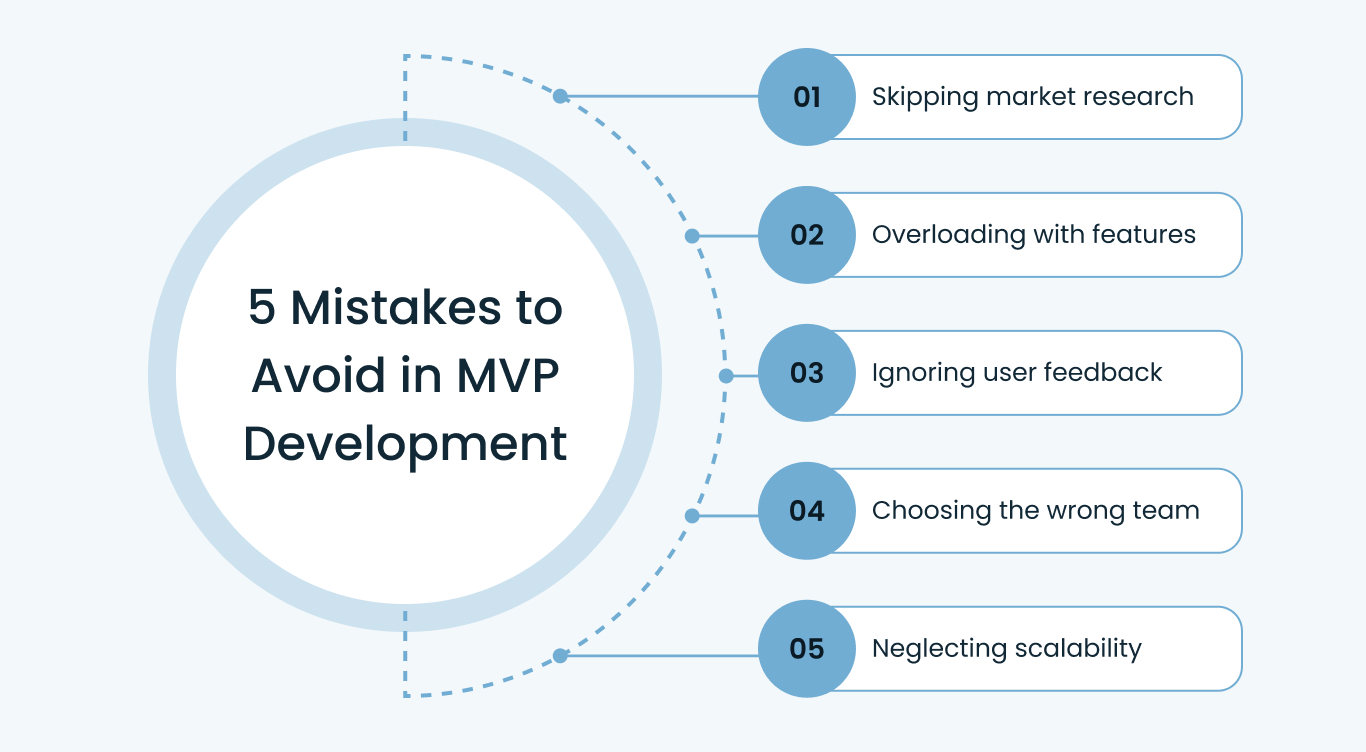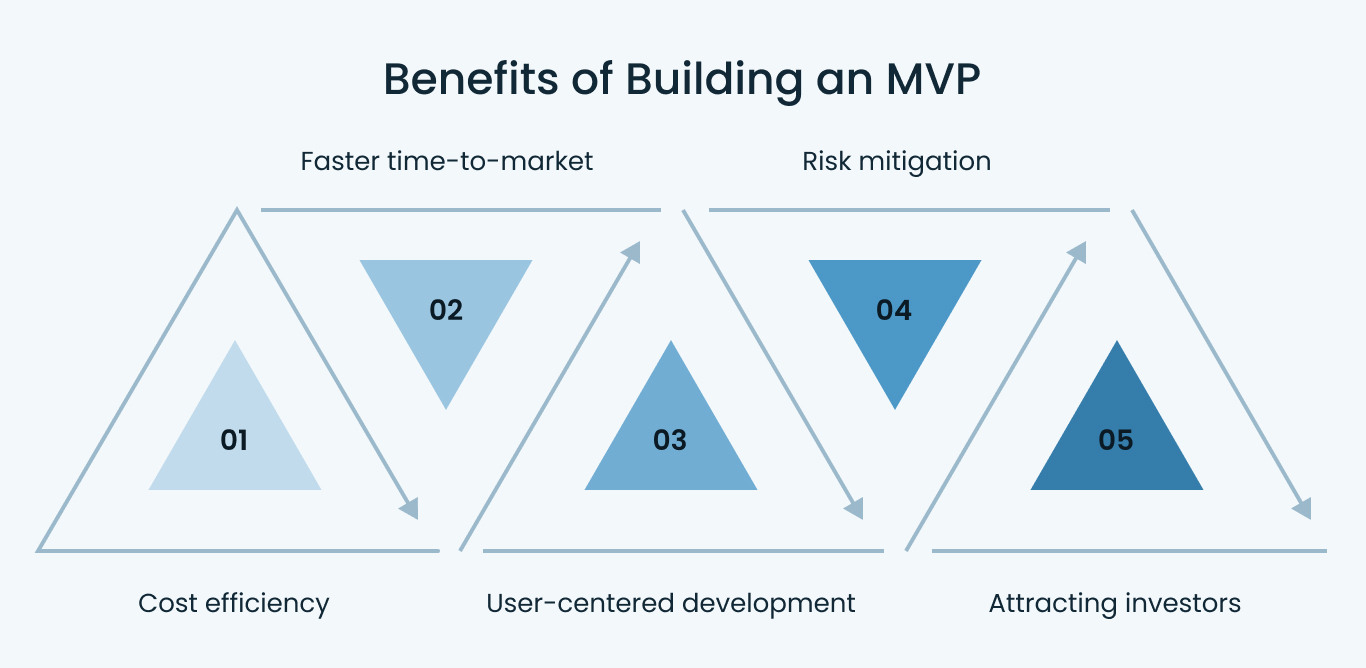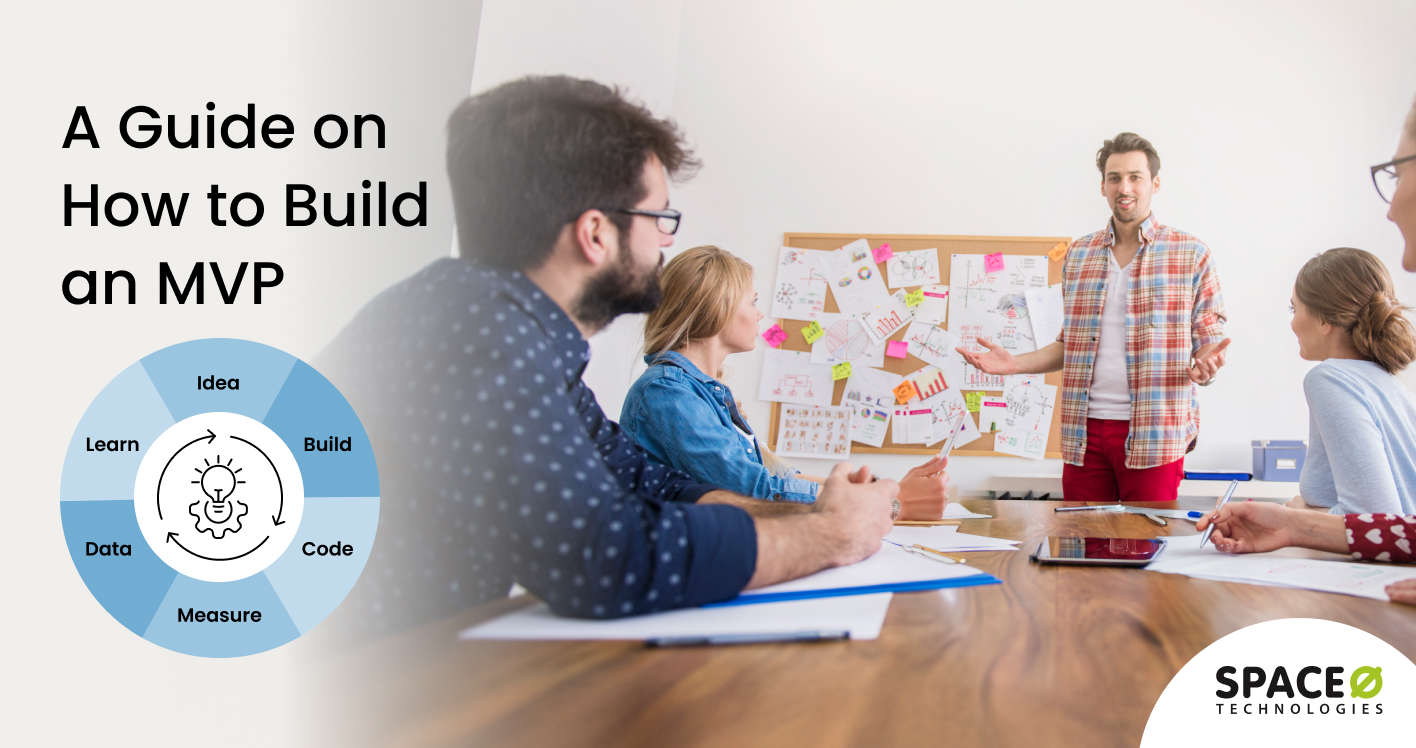Table of Contents
Got a product idea, but are you unsure if people will actually use it?
Opt for Minimum Viable Product (MVP). It is one of the best ways to validate your product concepts without spending a lot of time, budget, or resources.
According to CB Insights reports, 35% of startups fail because the product they build doesn’t meet any real market demand. MVP development helps test your idea early and determine if there’s real demand.
In contrast to traditional product development, which demands significant upfront investment, MVP development focuses on launching a simplified version of your product with just the core features. This approach helps you enter the market faster, collect feedback from real users, and make data-driven decisions. To facilitate this process, many teams rely on MVP development services that specialize in quickly turning ideas into workable prototypes.
In this blog, we will provide a step-by-step guide on how to build an MVP, including its main purpose, cost, common mistakes to avoid, relevant case studies, and key advantages.
What is an MVP?
An MVP (Minimum Viable Product) is the primary version of the product, comprising only the essential features. The main objective of building an MVP is to quickly launch a functional product, test hypotheses, and gather user feedback with minimal effort. This approach is essential in validating the product concept and explaining users’ preferences before starting full-scale development.
With MVPs’ focus on core functionalities, organizations can assess market demand and make informed decisions about future improvements. This step-by-step approach minimizes the risk of building irrelevant features and ensures the final product version is closely aligned with the customer’s requirements.
Now that we understand what an MVP is, it’s equally important to understand its main purpose and how it drives product development and business strategy.
What is the Main Purpose of an MVP?
The main goal of a Minimum Viable Product (MVP) is to validate a product idea. This is done by creating and introducing a simple version of a product with its core features to the market. With this approach, organizations can test their hypothesis and learn about customer preferences with minimal investment.
Key objectives of an MVP include:
- Efficient market entry: Launching the basic product version quickly enables organizations to engage early adopters and establish a market presence ahead of competitors.
- Risk mitigation: With minimal initial investments, an organization can assess the viability of its product concept without incurring significant expenses.
- Resource optimization: Focusing on important features helps organizations deliver immediate value and prevents the wasting of resources on untested features.
- Foundation for effortless development: MVP is the initial point for continuous improvements. It enables businesses to refine and expand their product based on validated learning and evolving market demands.
Organizations using the MVP approach make informed decisions, ensuring investments go towards features that meet user needs and have proven market potential.
Ready to Turn Your Idea into an MVP?
Don’t just sit on your startup idea; take the first step toward launching a real product. Get expert guidance to plan, validate, and build your MVP correctly.

With a clear understanding of the main purpose of an MVP, let’s get into the key steps involved in building one effectively.
8 Key Steps to Build a Minimum Viable Product

Building a Minimum Viable Product (MVP) is a strategic approach to efficiently validate product ideas. Here is a step-by-step guide to help you through the process:
Define the problem and target audience
The MVP development process starts with identifying the issue. Once you know the problem, you can devise a solution. Each product is created for a specific purpose or to address a particular problem. So, you need to identify the problem your product aims to solve and its respective target audiences.
Understanding your target audience’s pain points and demographics is essential. This knowledge becomes the foundation for a product that resonates with their needs and preferences.
Every product provides real value to customers. You must consider this while developing your minimal viable product (MVP). You should understand the problem and ensure that your MVP addresses it in the best possible way.
Conduct market research
Once you have identified the problems, it is time to analyze the market. Most startups fail due to a lack of market research. If your product doesn’t solve the core issue, users won’t use it.
To avoid such situations, conduct market research and ensure your product meets the target market’s needs. The more information you have, the higher the chances of succeeding. When conducting market research, don’t forget to examine what your competitors offer and how to make your product stand out.
Another primary reason startups fail is a lack of funds. Validate your business idea, ensure that your target audiences will pay for the products, and help your business grow further.
Define core features
Now, it is time to define the core functionalities of your MVP or plan the scale of the minimum viable product. Initiate the process by explaining some basic features that are most important to your target market.
After this, think about other features that you want to add to the product and prioritize them. Determine which functions are crucial to implement immediately and which can be added later during project development.
It is advisable to set function priorities with the team. Through discussions and debates, you can determine the optimal scope for your minimum viable product.
Develop a prototype
What is the need to develop a prototype and an MVP at this step? A prototype is an early version that shows how something might work, while a minimum viable product (MVP) is a basic version of the product that performs its primary functions.
Start by creating a basic prototype to visualize the user interface and experience. This preliminary model is a tool for early testing and feedback, allowing you to refine the design and functionality before full-scale development. Some of the best examples of prototypes are sketches, wireframes, and paper prototypes.
Build the MVP
During the development stage, you must ensure that your MVP is bug-free and of high quality. This initial product version will enable your target users to appreciate the core value of your product, laying a strong foundation for its continued development and improvement.
Another essential point to consider is the different types of MVPs. The kind of MVP significantly impacts the scope of work and development time. First, decide on the MVP type and then lay out the estimated timelines.
Launch to early adopters
Introducing the Minimum Viable Product to early adopters is one of the most essential steps in the product development journey. These initial customers or industry experts are crucial in providing valuable feedback and validating the market fit of your product.
To engage your early users, identify the communities where they gather, such as niche forums, social media groups, or professional networks. To facilitate easy communication, you can also establish open channels to gather valuable feedback, like in-app surveys or dedicated forums.
Collect and analyze feedback
Collecting and analyzing user feedback helps refine your Minimum Viable Product (MVP) to ensure it aligns with user needs and expectations. Start by implementing different feedback collection methods, such as surveys, user interviews, and usability tests, to gather both quantitative and qualitative data.
After collecting the feedback, organize it in a systematic way. You can categorize it based on various themes, such as usability, functionality, and performance, to identify recurring patterns and prioritize areas for improvement.
Ask your development team to analyze this data to understand the user’s challenges and preferences clearly. Prioritize the feedback based on the frequency of mentions and its impact on user satisfaction. Lastly, integrate these valuable insights into your product roadmap for iterative development.
Iterate and improve
Incorporating user feedback is essential for refining your product to meet user expectations. This approach consists of moving through planning, development, testing, and review stages, allowing for enhancements based on real-world feedback.
Implementing changes based on users’ valuable insights helps developers address identified issues, enhance functionality, and improve the overall user experience. Ensure that you engage with your audiences regularly and integrate their feedback. This helps identify unforeseen challenges and achieve product-market fit.
By following these key steps, you can successfully build an MVP. However, being aware of common pitfalls hindering your progress is also essential.
5 Common Mistakes to Avoid When Building an MVP

Developing an MVP comes with its challenges and pitfalls. Below are 5 common mistakes to avoid as you start your MVP development journey.
Skipping market research
Inadequate market research leads to creating a product that fails to address real user needs or market demand. Conduct thorough research to understand your target audience, market trends, and the competitive landscape so that you can avoid such a situation. Use this information to validate your product idea and ensure its relevance.
Overloading with features
One of the most common mistakes is overcomplicating the MVP by including too many features. Always focus on the main functionalities that address the core issue and provide value to users. Eliminate any unnecessary features that might delay the development process and increase costs.
Ignoring user feedback
Overlooking user feedback could lead you to miss opportunities for improvement. Keep seeking and analyzing user feedback to make informed decisions and improve your product. Paying attention to user feedback can ensure the success of your minimum viable product.
Choosing the wrong team
Selecting an inexperienced or unprofessional development team can lead to poor execution and project failure. Collaborating with a team that possesses the necessary skills and experience in MVP development for startups ensures a smooth process and a high-quality product for your organization.
Neglecting scalability
Focusing on immediate goals is important, but neglecting the scalability of your MVP can lead to significant challenges as your user base expands. Design your products with scalability in mind from the very beginning. This ensures its ability to handle increased demand and evolving requirements.
Understanding these common mistakes can help you navigate the challenges of MVP development. Let’s look at real-world examples of successful MVPs to see how they overcame these challenges and achieved success.
Case Studies of Successful MVPs
Here are some inspiring case studies of successful Minimum Viable Products (MVPs), where organizations have turned simple ideas into global successes.
Uber
In 2009, Travis Kalanick and Garrett Camp developed UberCab, an app that enables users to book car rides in San Francisco. Their MVP focused on connecting users with drivers, offering a cashless payment option, and creating a user-friendly interface.
The MVP helped them understand the demand for cab services, which led to the expansion of Uber’s services. Furthermore, they added more services, such as Uber X and Uber Eats. Today, Uber has a presence in numerous countries, revolutionizing urban transportation.
Amazon
In 1995, Jeff Bezos started Amazon as an online bookstore. The MVP consisted of a simple website with a list of available books. Once orders were placed, Bezos would purchase the books from distributors and ship them to customers, manually handling the fulfillment process.
Opting for MVP web development helped Amazon understand customer preferences and validate the e-commerce model. With growing demand, Amazon extended its product offerings and invested in automated warehouses and logistics. Finally, Amazon evolved into a global retail giant, with its popularity worldwide.
Dropbox
Drew Houston created a simple explainer video showcasing Dropbox’s file-syncing capabilities. This deliberate move aims to gain interest and collect early feedback before full development.
Dropbox MVP’s positive reception led to a significant increase in beta sign-ups, confirming market demand. This product validation helped Dropbox to secure funding and develop a product, eventually becoming a leading cloud storage provider.
Instagram (Formerly known as Burbn)
In 2010, Kevin Systrom and Mike Krieger launched Instagram (formerly known as “Burbn”). When launched as an MVP, the application was power-packed with several features, enabling users to check in at locations, plan future check-ins, earn points, and post pictures.
During this time, the founders discovered that the photo-sharing feature was more popular than all the others. They decided to focus solely on the photo-sharing features with filters, renaming it Instagram. These changes were welcomed by the users, which led to rapid growth and its eventual acquisition by Facebook.
Time to Bring Your MVP Idea to Life
Done with planning and research? Let Space-O help you turn that strategy into a working MVP designed for speed, focus, and real-world validation.
These case studies showcase the potential of MVPs to drive innovation and growth. Now, let’s examine the advantages of building an MVP for your business.
What are the Advantages of Building an MVP?

Developing a Minimum Viable Product (MVP) offers several strategic advantages for businesses aiming to introduce new products or services. Key benefits include:
Cost efficiency
Opting for an MVP helps you reduce initial development costs by focusing on the core features that solve the primary user problem. This approach enables you to allocate your resources effectively and avoid heavy investments in features that may not align with user needs.
Faster time-to-market
With an MVP, organizations can launch their product faster than the full-fledged version. This process enables organizations to establish an early market presence, gather user feedback, and make necessary adjustments. Rapid development is essential in dynamic markets where being first can provide a remarkable competitive edge.
User-centered development
An MVP provides early engagement with users, enabling organizations to get early feedback on the product’s core functionalities. This ensures that the following development aligns closely with actual user preferences and requirements. With this, you can be assured that the product will align with market demand.
Risk mitigation
MVP comes in handy for validating the product concept before investing extensive resources. Assessing the market demand from the very beginning helps businesses to identify and address potential issues, reducing the risk of product failure. This farsighted strategy enables informed decision-making regarding further investment and development.
Attracting investors
A well-prepared MVP showcases an organization’s commitment to cautious resource management and responsiveness to market needs. By displaying the initial user adoption and feedback, organizations can provide tangible evidence of the product’s potential, making it more appealing to potential investors seeking validated opportunities with reduced risk.
After understanding the benefits of building an MVP, the next question is often about the financial investment required. Let’s break down the costs involved in creating a minimum viable product (MVP).
How Much Does it Cost to Build an MVP
The average cost to build an MVP (Minimum Viable Product) ranges from $15,000 to over $ 150,000, depending on the product’s complexity and scope. The final cost largely depends on various factors, such as:
- Core features and functionalities are included in the Minimum Viable Product (MVP).
- Technology stack selected, including programming languages, frameworks, and APIs.
- Design complexity and user experience (UX) requirements.
- Developer rates vary based on expertise and region.
- Platform types include mobile (iOS and Android), web, and cross-platform solutions.
Other considerations, such as third-party integrations, compliance needs, and post-launch support, can also affect the total cost. Businesses should define a clear MVP software development plan and scope to effectively manage costs.
Considering the advantages of building an MVP, it’s crucial to establish how to measure its success and ensure that it aligns with your business goals.
How to Measure the Success of an MVP?
After launching your MVP, the most crucial step is to closely monitor its performance. Focus on tracking key performance indicators (KPIs) to scale your product’s success. Here are some essential metrics to help you evaluate its post-launch performance.
User acquisition
This metric assesses the effectiveness of your strategies in attracting users to your product. Monitoring the number of new sign-ups or downloads over a specific period provides valuable insight into the reach and appeal of your MVP.
User engagement
Assessing the number of active users interacting with your product helps its relevance and usability. Key metrics, such as Daily Active Users (DAU), Monthly Active Users (MAU), session length, and frequency of use, indicate the level of user engagement.
Conversion rates
This metric measures the percentage of users who have purchased or subscribed to the service. Higher conversion rates mean the MVP meets the user’s needs and encourages them to progress through the user journey.
Customer retention
Keep track of the number of users who continuously use your product over time, reflecting its long-term value and satisfaction. The retention rates indicate how well your MVP holds onto users. Additionally, it highlights areas where improvements are needed to maintain user engagement.
Customer feedback
Gather qualitative feedback through surveys, reviews, and direct communication to gather valuable information on user satisfaction and areas for improvement. A detailed understanding of user perceptions helps improve the product to meet the demands of the target market.
Revenue metrics
Evaluating financial performance indicators like average order value, revenue growth rate, and customer acquisition cost. These factors clearly show the MVP’s profitability and economic viability. These metrics are crucial for assessing the financial sustainability of the product.
Churn rate
Last but not least, churn rate is another important measure that needs to be closely monitored by the MVP owners. Suppose customers aren’t staying for too long, then you won’t be able to achieve the average acquisition cost, which means that your product is running at a loss.
The churn rate measures the percentage of customers who stop using a service or product within a specified timeframe, such as canceling a subscription or uninstalling an app.
Build Your MVP with a Reliable Development Partner
Avoid costly mishaps and move forward with confidence. Get expert-led MVP development services customized to your vision, timeline, and goals.
Once you’ve successfully measured the performance of your MVP, it’s time to build on that success and create a product that can take off.
Turn Your MVP into a Scalable Product With Space-O Technologies
Building an MVP is only the beginning of your product journey. The real success lies in refining, expanding, and scaling the MVP based on real user feedback and market needs. At Space-O Technologies, we offer the finest MVP development services to validate your business idea and turn it into a market-ready product.
With over 14 years of experience, we’ve worked with 115 startups and helped 35 secure Series A funding. From MVP design to full-scale product development, our team ensures your product grows with agility, reliability, and a future-ready roadmap.
Ready to scale your MVP into a full-fledged product? Contact our team at Space-O Technologies for a free consultation.
Frequently Asked Questions on How to Build an MVP
Should I build an MVP in-house or outsource development?
The choice between building an MVP in-house and outsourcing it depends on various factors. These factors consist of project timeline, technical capabilities, and resources. If your internal team is capable of handling the overall development process.
One of the best things about working with an internal team is overall control over the project. However, opting for an experienced MVP development agency can speed up time-to-market and bring in cross-industry expertise, especially when you need rapid prototyping.
Is an MVP only for startups, or can enterprises use them too?
MVPs are not meant just for startups. Enterprises use MVPs to test their new product ideas, look for innovation, and validate internal tools before investing in full-scale development. With MVPs, both startups and enterprises can reduce possible risks and make more informed decisions.
What’s the difference between an MVP and a prototype?
A prototype is a basic model meant for visualizing and validating the product design or concept. On the contrary, MVP is a functional version of the product with only the essential features that address a specific problem. You can think of a prototype as a draft and an MVP as a usable product.
How to transition from MVP to a full-scale product?
The process of transitioning from MVP to full-scale product involves analyzing user feedback, identifying which features are working, and adding new functionalities. During this process, it is essential to maintain flexibility and pay attention to the features appreciated by the overall user base.
What industries benefit the most from MVP development?
MVP development is most suitable for industries with rapidly changing consumer demands, such as health tech, SaaS, and e-commerce. However, any industry looking to transform or launch a new solution digitally can use MVPs to validate its ideas without a high upfront investment.



